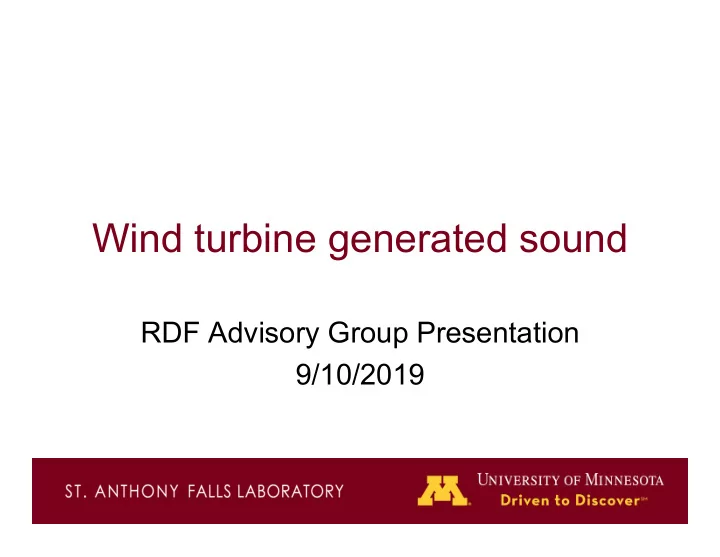

Wind turbine generated sound RDF Advisory Group Presentation 9/10/2019
Project Overview • Review literature on wind turbine noise characteristics and human response • Identify sound attributes for reproduction in human perception study • Collect and analyze infrasound and audible noise from wind turbine installations • Conduct laboratory assessment of human response to infrasound • Develop guidelines for noise monitoring and human impacts of wind turbine noise
Literature Review • Infrasound – potential health effects – Interference with vestibular system • Infrasound – Sound at frequencies below 20 Hz – Produced by wind turbines at the blade-passing frequency (~1 Hz) and its harmonics • Impulsive wave – Humans are insensitive to sound below 20 Hz
Pedersen, 2008
Literature Review • Amplitude Modulation – Systematic sound pressure level variation of audible noise – Broadband – “Thumping” – May be particularly annoying even at low sound levels – Often confused with infrasound
Noise Measurements • Developed method for measuring and quantifying infrasound – Difficult to measure/masked by natural background infrasound – Specialized equipment – Analysis method to identify peaks associated with wind turbine generated infrasound, quantify sound level • Method for measuring Amplitude Modulation and quantify the variation – Infrequent phenomenon – Requires long-term monitoring (equipment and data storage) – Algorithm for processing large amounts of data • Summarized method used • Guidelines developed for measuring and quantifying
Project Findings – Human Response Testing • Natural infrasound in the environment are at similar sound levels to wind turbine generated infrasound • No participants indicated motion sickness during testing – Infrasound levels presented at 100 times (40 dB) the level recorded in the field – Short duration testing (1 minute per stimulus, 15 minutes cumulative) • Previous research has indicated symptoms start quickly – Simulator sickness questionnaire indicated non-symptomatic for motion sickness
Project Findings – Noise Guidelines • Noise Monitoring Guidelines – Method for measuring and quantifying Infrasound – Method for measuring and quantifying Amplitude Modulation (AM) • AM is being included in international regulations of wind turbine noise – Summary of procedure for compliance testing • Responding to noise complaints – Background noise measurements
Project Findings – Human Response Review • Canada Health Report – Survey of 1238 individuals living near wind turbines – Noise levels at each dwelling estimated using commercial software – No relation between health effects and wind turbine noise level found • Self-reported health effects, sleep disturbance, sleep disorders, quality of life, perceived stress etc. – Non-acoustic variables found to be most significant factoring in predicting annoyance • Personal and contextual factors such as visual (blinking lights, shadow flicker, the turbine), attitude toward wind turbines and people responsible, process around planning/construction, economic interest/personal benefit, physical safety concerns etc.
Project Findings – Human Impact Guidelines • Human Impact Guidelines – EPA, 1974 1. Effect of noise on hearing 2. Effect of noise on mental state evidenced by annoyance 3. Interference of noise with activities 1. Speech Understanding 2. Sleep Disturbance 3. Concentration – Annoyance and sleep disturbance current concerns – Infrasound not significant health impact at levels associated with modern turbines
Project Findings – Human Impact Guidelines • Human Impact Guidelines – Current regulations protect against loss of hearing – No evidence that non-audible infrasound below (~100 dB-no weighting) has health impacts – Total noise at receptor should be used • Closest Turbine + Other Turbines + Other Manmade sources – Turbine specific noise characteristics such as AM are starting to be regulated – Non-acoustic factors are most significant variable in predicting annoyance • Address these issues
Recommend
More recommend